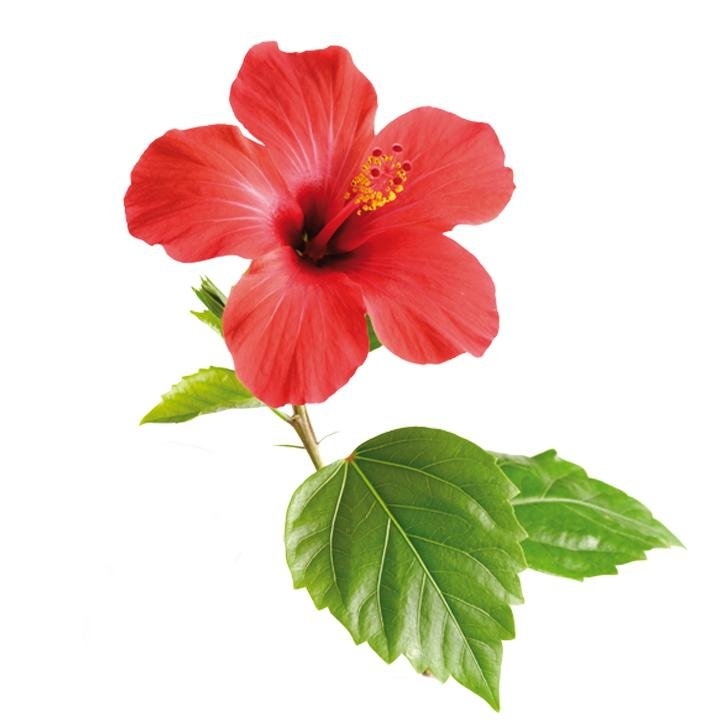Hibiscus sabdariffa L.
Description
It is an annual plant of the Malvaceae family that can reach 1 to 3 meters in height. Native to tropical Africa, it is cultivated in other regions such as Southeast Asia and Central America, and in other regions with dry, subtropical, mountainous, thorny scrub climates. The leaves are tri- or pentalobulate, about 15 cm long, alternate on the stem. The flowers are conical in shape and consist of 5 deep red calyxes.
It is also known as Jamaica flower or Abyssinian rose.
Part used
The flowers (calyxes and epicalli).
Active ingredients
- Organic acids (15-30%): citric, malic, tartaric acids and the lactone of (+)-alohydroxycitric acid, known as hibiscus acid.
- Anthocyanins (approximately 1.5%): 3-O-sambubiosyl-delphinidin (hibiscin), 3-O-glucosyldelphinidin, delphinidin, 3-O-sambubiosyl-cyanidin and 3-O-ß-D-glucopyranosyl-cyanidin.
- Flavonoids: quercetin, myricetin, hibiscetin, hibiscitrin, sabedaretin and 3-O-glucosyl-gosipetin.
- Phenolic acids: protocatechuic, o-coumaric, p-coumaric and ferulic acids.
- Mucilaginous polysaccharides and pectins, including a rhamnogalacturonan, accompanied, to a lesser extent, by an arabinogalactan and an arabinan.
- Phytosterols: campestrol, ergosterol, beta sitosterol, stigmasterol.
- Vitamins (C, E, carotenoids, riboflavin, thiamine, niacin, etc.) and minerals (calcium, iron, magnesium, manganese, selenium, etc.).
- Traces of essential oil (with eugenol).
Pharmacological action
- Antibacterial: against the usual bacteria responsible for urinary tract infections (Escherichia coli, Staphylococcus aureus, Bacillus subtilis and Pseudomonas aeruginosa). Prevents adherence, multiplication and colonization of urinary tract cells by these bacteria.
- It does not destroy or alter the intestinal flora.
- Urine acidification: creates an environment that hinders the proliferation of bacteria in the urinary tract.
- Antifungal: it shows great effectiveness in reducing initial microbial contamination also for Candida albicans.
- Urine deodorizing: so it can be very useful in urinary tract infections or in people with urinary incontinence.
- Preventive action for urinary tract infections and limiting the risks of repeat infections. In some studies it has been shown that the use of hibiscus reduces recurrent urinary tract infections by 77%, mainly in women.
- Other actions described: analgesic and anti-inflammatory (useful to relieve discomfort caused by urinary tract infections), diuretic, hypotensive, hypocholesterolemic, mild hypoglycemic, antioxidant, choleretic, among others.
Indications
- Prevention and treatment of lower urinary tract infections (cystitis, urethritis).
- To enhance the efficacy of antibiotic treatment in urinary tract infections, which will lead to a reduction in their consumption.
- Patients with repeated urinary tract infections: elderly people, diabetics, bedridden, prolonged use of catheters, urinary tract malformations, urinary incontinence, hormonal changes in women, post-menopause, chronic prostatitis, etc.
Contraindications
- Pregnancy and lactation
- Cardiac or renal insufficiency.
Precautions
- Arterial hypotension
- People with urinary uric acid, cystine or xanthine stones (due to urine acidification).
Drug interactions
It could potentiate the effect of diuretic and antihypertensive drugs.
Side effects
At the recommended doses have not been described.
Bibliography
Riaz G, Chopra R. A review on phytochemistry and therapeutic uses of Hibiscus sabdariffa L. Biomed Pharmacother. 2018; 102: 575-586.
F.A. Allaert. Prevention of recurrent cystitis in women: double-blind, placebo-controlled study of Hibiscus sabdariffa L. extract. Lettre de l’Infectiologue Tome XXV - n 2 - mars-avril 2010
Mounnissamy VM, Karimani S, Gunasegaran R. Antibacterial activity of gossypetin isolated from Hibiscus sabdariffa. The Antiseptic 2002;99:81-2.
Liu KS, Tsao SM., Yin MC. In vitro antibacterial activity of roselle calyx and protocatechuic acid. Phytother Res 2005;19:942-5.
Mojiminiyi FBO, Adegunloye BJ, Egbeniyi YA; Okolo RU. An investigation of the diuretic effect of an aqueous extract of the petal of Hibiscus sabdariffa. J Med Sci. 2000; 2: 77-80.
Mozaffari-Khosravi H, Jalali-Khanabadi BA, Afkhami-Ardekani M, Fatehi F, Noori-Shadkam M. The effects of sour tea (Hibiscus sabdariffa) on hypertension in patients with type II diabetes. J Hum Hypertens. 2009; 23 (1):48-54.
